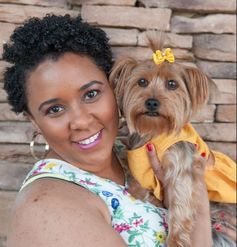 April Rose Blake and Lola Jae April Rose Blake and Lola Jae We are long overdue for a client spotlight and what better way to fix the problem than spotlighting one of our new outside general counsel clients: April Rose Blake. As a new resident of the metro-Atlanta area and a entrepreneur to the core we were destined to meet. A native of Jackson, Mississippi and a U.S. Army veteran, she came to the city with a passion and a drive that inspires everyone she comes in contact with. As a result of her determination and drive, she is ready to introduce her baby to the world. We are proud to announce the grand opening of My Swanky Pooch - A Luxury Pet Spawtique in Alpharetta, Georgia. The grand opening will be held at the retail store on April 22, 2017 from 11 am - 3 pm. Lola Jae, My Swanky Pooch's official brand ambassador, can't wait to meet you and your fur babies. What is My Swanky Pooch? My Swanky Pooch is an upscale dog boutique that sells designer dog clothes, unique pet accessories, and luxurious pet furniture. They even offer embroidery services. At My Swanky Pooch, every pooch is special and deserves to be treated as such. It is a beautiful place where you can shop for (and with) your beloved fur baby. The spawtique even has dressing rooms so you can try the swanky wear on your fur baby in the store. Whether you are looking for organic bath and body products for your pet, pet umbrellas, Atlanta sports gear for your fur baby, fashionable carriers or clothes; My Swanky Pooch has you covered. They even offer custom Gucci and Louis Vuitton apparel for your pet. 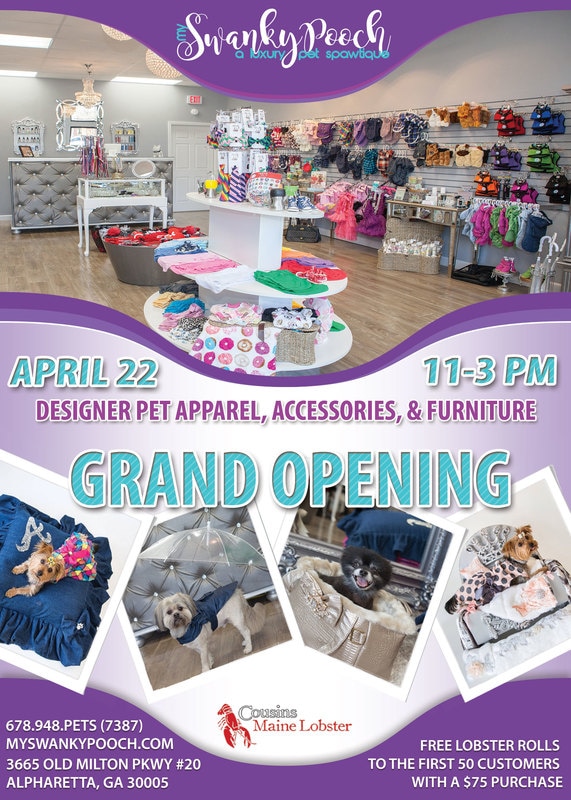 During the grand opening event, My Swanky Pooch will offer a "pawesome" art activity for fur babies and pet parents alike, paw polish, and stencil art for pets. There will also be a photo booth to capture the memories along with treats for everyone during this fur family event. As an extra treat, Cousins Maine Lobster Truck will be on site during the grand opening and My Swanky Pooch will buy a lobster roll for the first 50 customers who spend $75 or more during the grand opening event. If you can't make it, you can always shop online at www.myswankypooch.com.
For more information, you can email them or follow them online for all of the latest news:  As you prepare to register your mark, you have to decide if you are going to register a standard character drawing, also known as a word mark, or a special form drawing, also known as a design mark. You might be wondering, what is the difference between the two drawings? For starters, a standard character drawing consists solely of words, letters, or numbers and protects the wording itself. While a special form drawing protects a specific design which could include colors, words, special drawings/characters, etc. A standard character drawing/word mark, protects only the registered word, without regards to any particular font, style, size, or color. Because a standard character drawing/word mark protects the word in any format, it provides the broadest protection for its owner. According to the United States Patent and Trademark Office ("USPTO"), in order to qualify as a standard character drawing/word mark, the mark must have the following characteristics: • No design element; • No stylization of lettering and/or numbers; • Any letters and words in Latin characters; • Any numbers in Roman or Arabic numerals; and • Only common punctuation or diacritical marks. A special form drawing/design mark, on the other hand, is for everything else. If your mark includes a particular style of lettering, particular color(s), special designs, pictures, etc., with or without words, you do not qualify for a standard character drawing/word mark and must file a special form drawing/design mark. There are lots of rules that apply when filing a special form drawing/design mark. For example, if color is not a feature of the special form drawing/design mark, then a black-and-white drawing should be filed. Many brands register both a word mark and a design mark because they protect different things. As you develop your intellectual property strategy for your business, be sure that you consider what needs to be protected and how you can protect it. For more information on trademarks, checkout our blog, visit the Trademark section of the USPTO, and/or contact your favorite attorney. 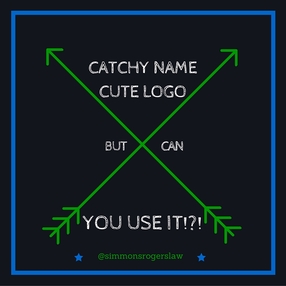 You finally came up with the perfect name and/or logo for your brand but can you use it? Did you check to see if someone already trademarked your brilliant idea? Even if your exact idea is available, have you checked to see if it is similar to someone else's trademark. You can't use your mark if there is a "likelihood of confusion". What is likelihood of confusion? Essentially, likelihood of confusion exists when (1) the marks of the parties are similar and (2) the goods and services associated with the marks are related in such a way that people are likely to believe they are from the same source. To determine if your new name or logo is confusing, you have to look to see if the mark looks like, sounds like, has a similar meaning, or creates a similar overall commercial impression to the registered mark. For example, if your name is "The Mane Tamer" for natural hair products and someone else has registered "The Main Tamer" for chemical perms then you should probably pick another name. Why? Because these names look alike, sound alike when spoken, and arguably have similar meanings. Which means the first element in the likelihood of confusion test has been met. The second element deals with the goods and services being sold. Since the names are for related products, remember the goods or services don't have to be identical to be confusing, then the name you chose "The Mane Tamer" is probably going to fail the second element likelihood of confusion test too. As such, your application for a trademark will be rejected by the United States Trademark and Patent Office ("USPTO"). Even if the USPTO did not find a conflict during their initial review, the owner of "The Main Tamer" would oppose and contest your mark and cause your application for the trademark "The Mane Tamer" to be rejected. If your name "The Mane Tamer" was in reference to horse grooming, then the likelihood of confusion would be significantly reduced and you would stand a better chance of being able to register your mark. You're a problem solver and you want to keep your name, so perhaps you are thinking you can just use the name without registering it. Wrong! Even if you don't file for a trademark, if you use the name on your natural hair products, the owner of "The Main Tamer" trademark could sue you for trademark infringement. In order to avoid all of these unpleasantries, when you are selecting a trademark for your business, be careful not to select one that causes a likelihood of confusion with another trademark. How do you do that? By performing a search for similar marks that are used on related goods and services before adopting your trademark. This is called a "clearance search" and involves searching federal and state trademark registration databases. It also involves a search for unregistered common law trademarks by searching the Internet for similar marks being used for goods and services related to yours. If you don't know how to perform a clearance search a trademark lawyer can assist you. It is much easier and cheaper to do the search before you waste resources building a brand only to later find out you can't use it and have to spend even more resources rebranding. 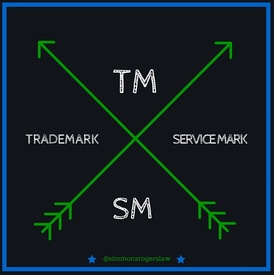 Have you ever seen these symbols and wondered what they are? "TM" and "SM" are usually used with an unregistered trademark or service mark, to inform the public that a term, slogan, logo or other indicator is being claimed as a trademark. "TM" and "SM" are also used when an owner has applied for trademark registration. While the use of the TM or SM symbol is not equal to federal registration. Using your trademark, in commerce, with specific goods and services, establishes legal rights in the mark, known as "common law" rights. You are entitled to these common law rights regardless of whether you use the TM or SM symbols in connection with your mark. However, these common law rights are limited. For example, in some situations, common law trademark rights for unregistered trademarks will only cover a limited geographic area. So what is a trademark? A trademark is a brand name. It is a word, phrase, design, or a combination thereof that identifies and distinguishes the source of goods of one party from those of others. In other words, a trademark lets your consumers know that your goods come only from you and not from anyone else. What is a service mark? A service mark is the same as a trademark, except that it identifies and distinguishes the source of a service rather than a product. When you see the terms "trademark" or "mark" used in reference to intellectual property, you should know that the terms "trademark" and "mark" refer to both trademarks and service marks. For more information on trademarks, check back with the blog for Part 2 of the Intellectual Property: Trademarks and Service Marks post, visit the Trademark section of the United States Patent and Trademark Office or contact your favorite attorney.  Intellectual property is one of the most valuable assets businesses (and individuals) own. There are several different forms of intellectual property, but this blog post will focus specifically on copyrights. In the United States, copyright law is based on federal laws enacted by Congress. The Copyright Act of 1976 governs copyright law and defines what can be copyrighted, what is copyright infringement, and the available remedies when there is infringement. A copyright is the exclusive legal right to copy, print, publish, perform, film, or record literary, artistic, or musical material, and to authorize others to do the same. Copyrights apply to original works in the form of a tangible medium. "Original" meaning brand new and "tangible medium" meaning in a fixed format including but not limited to: architectural works, blogs, books, choreographic works, graphic designs, photos, printed images, scripts, songs, and website content. As the author of the work and/or owner of the copyright you alone have the right to make copies of your work, distribute your work, make derivative works, perform your work publicly, display your work publicly, and make modifications to your work. These rights may be transferred or assigned in whole or in part by the author. Unless otherwise agreed in writing, work created by an employee is typically owned by the employer. As the owner of a copyright, it is generally illegal for anyone to copy, distribute, perform, or display work created by you without your permission. However, there are some exceptions and limits to your rights. And while a copyright is automatic, there are certain rights you can only get if you register with the US Copyright Office, such as the right to bring an infringement lawsuit and the ability to get statutory damages. A copyright attorney can help you register your work and protect your copyrighted work from further infringement. It is important to note copyrights do not last forever. Under the current laws, copyright protection starts from the moment of creation and continues until 70 years after the death of the author. That means that if in 2015 someone writes a song and dies in 2055, the copyright will not expire until 2125 - 70 years after 2055. If there are two or more authors of a work, then the term of copyright lasts for 70 years after the last surviving author's death. For works made for hire, and for anonymous and pseudonymous works, the duration of copyright is 95 years from publication or 120 years from creation - whichever is shorter. Once the term of a copyright expires, the work becomes apart of the public domain. When a work is in the public domain anyone can copy it and use it without permission. If you have questions about your rights as a copyright owner or a work that you are interested in protecting via copyright registration, contact the Atlanta based law firm of Simmons Rogers, LLC. As a small child, before the concept of a career was solidified, Makya knew she was destined to use her mind to create things and be her own boss. Taking the liberty to start her own laundry pressing service, complete with her own crayon drawn logos and repurposed dry cleaner packaging, Makya launched her first business. With an entrepreneurial spirit that could not be quenched, Makya has followed her passion and is now the proud owner of three companies.  As a student at Florida A&M University, Makya decided to change her major from Architecture to Graphic Design. She also took her first official step into the world of self-employment - creating Mareta Creations in her dorm room. As the company grew, Mareta Creations began to take on more projects, gaining valuable experience and pedigree, but financially the company was struggling. Driven by the love she had for her business and her clients, Makya dedicated the wealth of her time to the projects and far less attention to the business of her business. The cost of doing business began to heavily outweigh the the revenues of the business. As a result, Mareta Creations was forced into a hiatus. Despite the setbacks experienced during her first attempt at entrepreneurism, Makya decided to embrace them and learn from them. With a spirit of perseverance, Mareta Creations was relaunched in 2010. This time Makya decided to hire Attorney Maya Simmons Rogers of Simmons Rogers, LLC, to help her structure her business.
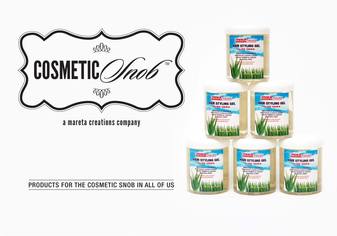 Makya continues to extend the reach of her businesses, utilizing her strong personal network and social media to connect with past, present, and future clients. Mareta Creations’ graphic design services have flourished and grown since the 2010 relaunch. The business now provides corporate design services, fine invitations and photography services for events, families, and pets. In 2013 and 2014, Mareta Creations was selected as one of The Knot's Best of Weddings Vendors. In 2013, after completing her Master's in Graphic Design at George Mason University, Makya launched Graphic Snob, an apparel company for the graphic snob in all of us. Most recently, in 2014, Makya launched Cosmetic Snob, where she sells cosmetic products through her online Amazon Store. Makya credits much of her polished self-presentation and business acumen to her experiences at Florida A&M University where she was able to observe the matriculation of students through the School of Business and Industry and “learn through osmosis”. As she carries Mareta Creations, LLC, the parent company, into the future, Makya keeps an eye for opportunities and professional growth. In the upcoming year, Mareta Creations, LLC will forge ahead with an added focus on corporate and government contracts and looks forward to opening its first physical storefront to showcase its products and projects. Visit www.MaretaCreations.com, www.GraphicSnob.com, and www.amazon.com/shops/cosmeticsnob to learn more about Mareta Creations, LLC's award winning products and services. |
Simmons Rogers, LLCSimmons Rogers, LLC is a full- service civil law firm based in Atlanta, Georgia. We provide legal services as well as mediation and arbitration services, to businesses and individuals throughout the state of Georgia and beyond. Archives
January 2018
Categories
All
This blog is not intended to be a complete explanation of the law. Its purpose is to inform, not to advise on any specific legal problem or legal rights. If you have specific questions regarding any topic in this blog, you are encouraged to consult the Atlanta based law firm of Simmons Rogers, LLC or an attorney licensed in your
state. |

Simmons Rogers, LLC
4045 Orchard Rd SE, Suite 210 Smyrna, Georgia 30080 Phone: 404-445-8146 Fax: 404-445-8226 E-mail: [email protected] |
LEGAL DISCLAIMER
The information on this website is for informational purposes only and is not legal advice. Use of this website does not create an attorney-client relationship between you and Simmons Rogers, LLC. You should not act upon the information within this website without seeking advice from a lawyer licensed in your own state or country. You should not send any confidential information to Simmons Rogers, LLC until and unless a formal lawyer-client relationship has been established in writing. Unless you have received such written confirmation, we will not consider any correspondence you send us as confidential. |
© 2013-2018. All Rights Reserved. Simmons Rogers, LLC
Attorney Advertising. The choice of a lawyer is an important decision and should not be based solely upon advertisements.
Privacy Policy
Attorney Advertising. The choice of a lawyer is an important decision and should not be based solely upon advertisements.
Privacy Policy

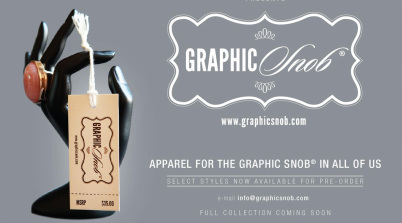
 RSS Feed
RSS Feed